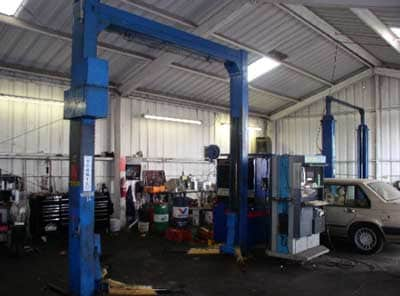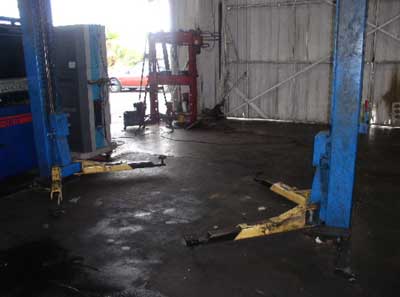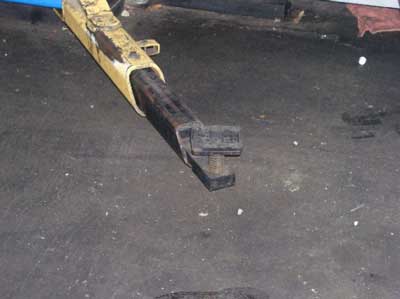An Automotive Mechanic Died When the Vehicle He Was Working Under Slipped Off A Lift and Fell On Him
Investigation: # 03CA010
SUMMARY
A 46-year-old male automotive mechanic died when the vehicle he was working under slipped off a lift and fell on him. The lift arms were not in alignment with the vehicle chassis when the vehicle was raised just prior to the incident, because the vehicle was too long for the lift to accommodate. The company had no safety or training programs available for the employees. The CA/FACE investigator determined that, in order to prevent future occurrences, employers, should:
- Establish and maintain an Injury and Illness Prevention Program (IIPP) for employees.
As part of the IIPP, employers should:
- Ensure the automotive lifts used in the workplace are capable of raising the vehicle safely.
INTRODUCTION
On November 21, 2003, at approximately 4:00 p.m., a 46-year-old male automotive mechanic died when the vehicle he was working under slipped off a lift and fell on him. The CA/FACE investigator learned of this incident on December 4, 2003, through the Legal Unit of the Division of Occupational Safety and Health (Cal/OSHA). On December 10, 2003, the CA/FACE investigator made contact with the employer of the victim. On December 11, 2003, the CA/FACE investigator traveled to the victim’s place of employment where he interviewed the employees at the shop. Pictures of the equipment and scene were taken, and other related documents were reviewed.
The employer of the victim was an automotive repair shop that had been in business for seven years. The company had four employees, all working at the facility where the incident took place. The victim had been employed with the company for two years. The employer of the victim did not have a written safety program. There were no written safe work procedures for jobs performed in the shop. Safety meetings were not held, and the company did not have a written training program.
INVESTIGATION
The site of the incident was an automotive repair shop which had eight bays and six lifts. The automotive lift involved in this incident was a 2-post, surface-mounted hydraulic lift with a capacity of 7,000 pounds that was manufactured around 1964 (Exhibits #1, 2, & 3). The vehicle involved in this incident weighed less than 7,000 pounds. The lifting arms on the lift were the outrigger type that were adjustable to accommodate the vehicle being lifted. The lifts were installed in the shop by the previous owner. The present owner had no manuals or books on the lift involved in this incident.
On the day of the incident, the victim was assigned to do repairs and maintenance on a crew cab pickup truck. The victim drove the vehicle into the bay and then adjusted the extension arms of the lift to accommodate the vehicle. The rear arms were unable to reach the spot where the vehicle manufacturer suggested they be placed in order to lift the vehicle safely. The victim placed the rear extension arms as far back as they could reach, then raised and lowered the vehicle many times throughout the work day depending on what procedure was being performed. As the victim raised the vehicle on the lift for the last time, the left-rear lift arm moved from its original position and was no longer positioned equally with the other arms to support the weight of the vehicle. The rear of the vehicle fell off the lift, and then the front of the vehicle came down, crushing the victim.
Two co-workers heard the noise and went to the bay where the victim was working. They lifted the vehicle off the victim using floor jacks. The paramedics were called, and the victim was transported to a hospital where he was pronounced dead.
CAUSE OF DEATH
The cause of death, according to the death certificate, was multiple blunt injuries.
RECOMMENDATIONS/DISCUSSION
Recommendation #1: Establish and maintain an Injury and Illness Prevention Program (IIPP) for employees.
Discussion: An Injury and Illness Prevention Program (IIPP) helps employers provide a safe and healthful work environment for employees by documenting the methods used to communicate with and train employees in their general safe work practices. It also gives specific instructions on hazards unique to their job assignments. In addition, it explains the employer’s obligation with regard to inspecting, identifying, and correcting hazards. This would include equipment that has no manual or other means of determining the manufacturer’s operating and maintenance procedures. A properly trained automotive mechanic would have been aware of the manufacturer’s recommendations as to where to place the lift arms when elevating their vehicle. A properly trained automotive mechanic would have also been aware of the limitations of the lifting equipment they were using. If an IIPP had been in place, this incident might have been prevented.
Recommendation #2: Ensure the automotive lifts used in the workplace are capable of raising the vehicle safely.
Discussion: The adjustable arms and pads on most automotive lifts are to accommodate the different designs of the many vehicles that might require lifting. The operator of the lift must set the arm in the specific spot under the vehicle, recommended by the vehicle manufacturer, in order to lift it equally and safely. If the arms cannot be placed in the proper position, then the vehicle should not be lifted. The lift involved in this incident was manufactured around 1964. When it was designed and manufactured, it could accommodate most vehicles on the road at that time. Today manufacturers engineer and design their vehicles to specifications quite different than 40 years ago. In this incident, the manufacturer of the lift was no longer in business. The employer had no manuals to determine what the manufacturer’s recommendations were for operation and maintenance. There may have been additional restrictions in the way this lift should have been used which a manual would contain. Although the weight capacity was within limits, in this particular case, the vehicle was too long for the lift to accommodate. Had the victim used a different lift with a longer reach, this incident might have been prevented.
REFERENCES
- California Code of Regulations, Title 8, Injury and Illness Prevention Program (Section 3203), and Automotive Lifts (Sections 3540 – 3549)
- American National Standard: ANSI/ALI B153.1-1990 Automotive Lifts – Safety Requirements for the Construction, Care, and Use
- American Lift Institute: Lifting it Right: ALI ALCTV-1998
FATALITY ASSESSMENT AND CONTROL EVALUATION PROGRAM
The California Department of Health Services, in cooperation with the California Public Health Institute, and the National Institute for Occupational Safety and Health (NIOSH), conducts investigations on work-related fatalities. The goal of this program, known as the California Fatality Assessment and Control Evaluation (CA/FACE), is to prevent fatal work injuries in the future. CA/FACE aims to achieve this goal by studying the work environment, the worker, the task the worker was performing, the tools the worker was using, the energy exchange resulting in fatal injury, and the role of management in controlling how these factors interact.
NIOSH funded, state-based FACE programs include: Alaska, California, Iowa, Kentucky, Massachusetts, Michigan, Minnesota, Nebraska, New Jersey, New York, Oklahoma, Oregon, Washington, West Virginia, and Wisconsin.
To contact California State FACE program personnel regarding State-based FACE reports, please use information listed on the Contact Sheet on the NIOSH FACE website. Please contact In-house FACE program personnel regarding In-house FACE reports and to gain assistance when State-FACE program personnel cannot be reached.
EXHIBITS
 |
|
Exhibit #1. A picture of the automotive lift involved in this incident.
|
 |
|
Exhibit #2. A picture of the automotive bay and lift with the adjustable lift arms.
|
 |
|
Exhibit #3. A picture of the automotive lift arm with the adjustable pad on the end.
|
